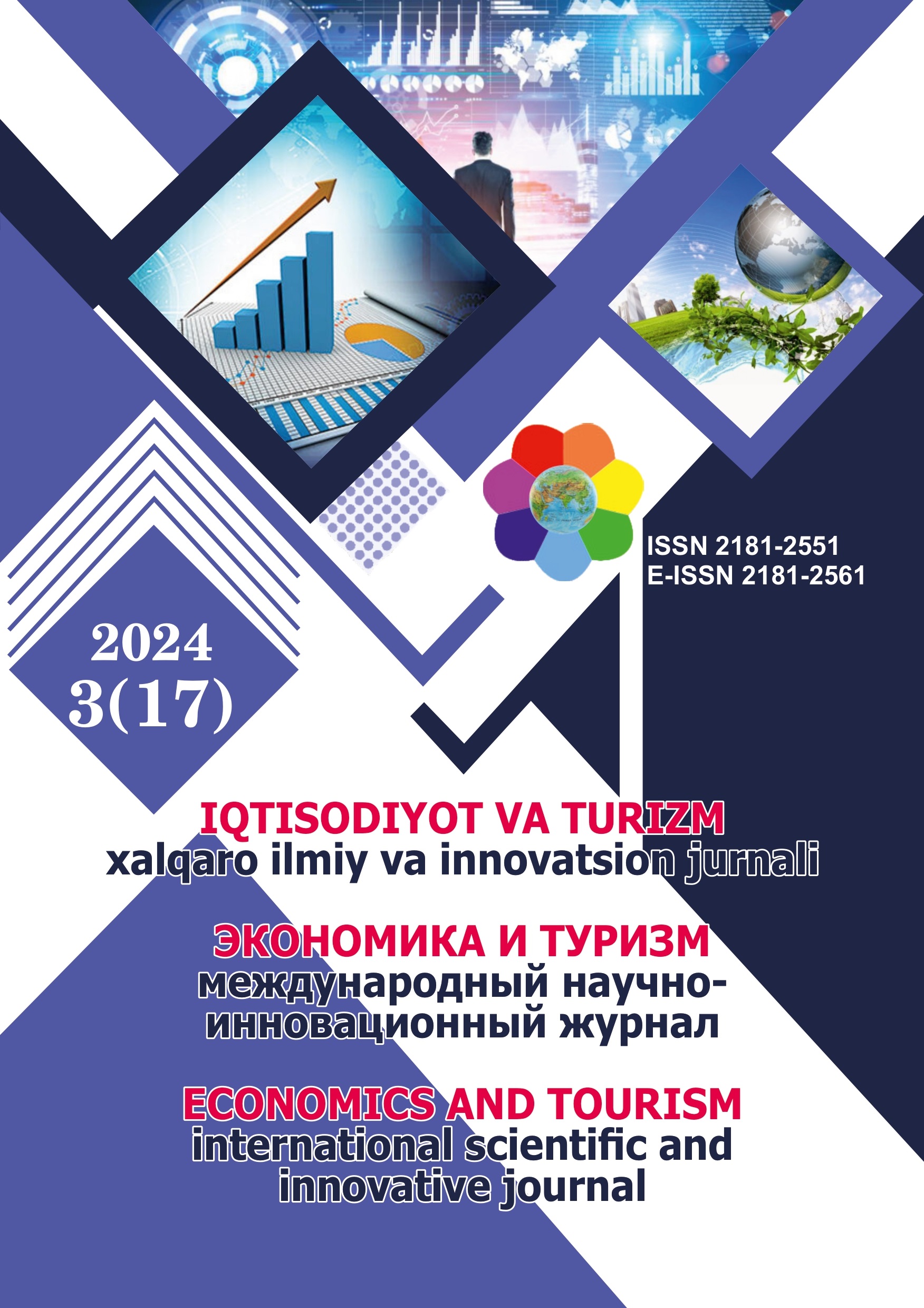TALABA VA YOSHLAR SAYOHATINING NAZARIY JIHATLARI HAMDA UNI RIVOJLANTIRISH STRATEGIYALARI
##article.subject##:
talaba va yoshlar sayohati va turizmi, sayohat xususiyatlari, marketing strategiyalari##article.abstract##
Talabalar turizmi sayyohlik sanoatining o‘sib borayotgan segmenti bo‘lib, yoshlar ko‘proq chet elda ta’lim va madaniy tajribalarni izlamoqda. Mazkur maqolada talaba va yoshlar sayohatining tushunchasi, xususiyatlari va turlarini o‘rganish jarayonida xalqaro tajribalar asosida olib borilgan ilmiy tadqiqotlar asosida talabalar, yoshlar va ularning sayohati, talabalar turizmi ishtirokchilarining turlari, xususiyatlari, motivatsiyalari tadqiq qilingan. Shuningdek, mazkur nazariy tadqiqot asosida talabalar turizmini rivojlantirishning marketing strategiyalari taqdim qilingan.
Библиографические ссылки
Chapman David. Director General. WYSE Travel Confederation 18 October 2019 | World Tourism Conference. New Horizons III Exucutive summary, A global study of the youth and student traveller.
Youth Student & Educational Travel Statistics Report 2018. British Educational Travel Association (BETA), London, UK.
Alice, D. 2004. Youth tourism in Canada – A situational analysis of an overlooked Market. Canada: Youth Tourism Consortium of Canada.
Carr, N. 2000. An exploratory study of gendered differences in young tourists perception of danger within London. Tourism Management 22:565-570.
Sullivan, A. 2004. Defining trends in youth travel in Australia. In The World Youth and Student Travel Conference 2004. Madrid: World Youth and Student Travel Conference.
Richards, G. (2015). The new global nomads: Youth travel in a globalizing world. Tourism Recreation Research, 40(3), 340–352. https://doi.org/10.1080/02508281.2015.1075724
Wearing, S., and Neil, J. (2001). Expanding Sustainable Tourism’s Conceptualization:Ecotourism, Volunteerism and Serious Leisure. In S.F. McCool and R.N. Moisey,eds.Tourism, Recreation and Sustainability, Linking Culture and the Environment, pp.233-255
King, B., Richards, G., & Chu, A. M. C. (2023). Developing a tourism region through tourism and culture: bordering, branding, placemaking and governance processes. Tourism Recreation Research, 1–15. https://doi.org/10.1080/02508281.2023.2207156
Crossley, E. (2012). Poor but happy: volunteer tourists’ encounters with poverty. Tourism Geographies, 14(2):235-253.
Zulhaimi, N., Halim, M. S. A., & Zawawi, M. M. A. (2018). The Motives of Volunteerism Involvement in the Tourism Sector. International Journal of Academic Research in Business and Social Sciences, 8(6), 290–304.
Bywater, M., Youth and student travel market, Travel & Tourism Analyst Vol. 3, 35-50, 1993.
Akhrorova, N. U. (2022). Swot Analysis in Youth Tourism Development Strategies for Uzbekistan. American Journal of Economics and Business Management, 5(12), 26-33.
Jones, D., Social Tourism in the E.U. - Student & Youth Travel, European Commission Seminar, Brussels, 2007.
Todorovic, N., Apelic, J. & Romic, G. (2015). Characteristics of foreign youth tourism in Belgrade.
World Economic Forum (2013) The Travel & Tourism Competitiveness Report 2013 World Tourism Organization International conference on youth tourism, New Delhi (India): Final report.
Glover, P. (2010), “Generation Y’s future tourism demand: some opportunities and challenges”, in Benckendorff, P., Moscardo, G. and Pendergast, D. (Eds), Tourism and Generation Y, CAB International, Cambridge, MA, pp. 155-63.
Mumuni, A. G. & Mansour, M. (2014). Activity-based segmentation of the outbound leisure tourism market of Saudi Arabi. Journal of Vacation Marketing, 20(3), 239-252.
Moisa, C. O. (2010). Aspects of the youth travel demand. Annales Universitatis Apulensis: Series Oeconomica, 12(2), 575.
Caroline Wangari Njagi (2017). Understanding the travel motivation among youth travelers in Kenya: the ‘push’ and ‘pull’ paradigm.
Kim, K. (2008). Analysis of structural equation model for the student pleasure travel market: motivation, involvement, satisfaction, and destination loyalty. Journal of Travel & Tourism Marketing, 24(4), 297-313Lee, U. & Pearce, P.L. (2002).
Maoz, D.: Backpackers Motivations: the role of culture and nationality. In: Annals of Tourism Research 2006 vol. 34, no. 1, p. 122-140.
Reisinger, Y. and Mavondo, F. (2003) Gender Differences in the Psychographic Profiles of The Youth Travel Market. TTRA
Richards Greg, Wilson Julie, (2003), Today’s Youth Travellers: Tomorrow’s Global Nomads. New Horizons in Independent Youth and Student Travel, Amsterdam: International Student Travel Confederation (ISTC).
Richards, G. (2023). Marketing countries, places, and place-associated brands: Identity and image, by Nicolas Papadopoulos and Mark Cleveland: Cheltenham, UK, Edward Elgar, 2021. Journal of Urban Affairs, 45(4), 891–893. https://doi.org/10.1080/07352166.2022.2107381
Richards, G.: New Horizons II – The Young Independent Traveller 2007. Amsterdam, WYSE Travel Confederation, 2007
Akhrorova, N. (2023). THE ROLE OF INTERNATIONAL BUSINESS IN THE DEVELOPMENT OF YOUTH TOURISM AND TRAVEL. ЦЕНТР НАУЧНЫХ
ПУБЛИКАЦИЙ (buxdu. uz), 34(34).
Understanding millennials’ tourism experience: values and meaning to travel as a key for identifying target clusters for youth (sustainable) tourism. Elena Cavagnaro, Simona Staffieri and Albert Postma, Journal of Tourism Futures, Vol. 4 Issue: 1, pp.31-42
Uktаmоvnа, А. N. (2023). THЕ FОRЕIGN СОUNTRIЕS’ЕXРЕRIЕNСЕ ОN TОURISM АND УОUTH РОLIСУ
Kim, K., Oh, I-K. & Jogaratnam, G. (2007). College student travel: A revised model of push motives. Journal of Vacation Marketing, 13(1), 73–85.
Morgan, M. & Xu, F. (2009). Student Travel Experiences: Memories and Dreams. Journal of Hospitality Marketing & Management, 18(2), 216-236.




